Deterministic Weather Forecasting
In 2020, the global energy industry depends on high-quality weather forecasts for critical decision making like never before. Over recent decades the application of these forecasts has expanded exponentially due to the rapid growth of renewable energy and the liberalization of energy markets.
Short-range forecasts are now an essential tool in the real-time management of wind and solar assets, whilst medium-range forecasts play a crucial role in daily hedging activity. Even though modern computing power has brought huge improvements to forecast accuracy, there remains an inconvenient truth at the heart of traditional weather forecasting: there is still very little deterministic skill in the long term, generally considered a forecast beyond 12 days ahead. Enter the long-range forecast.
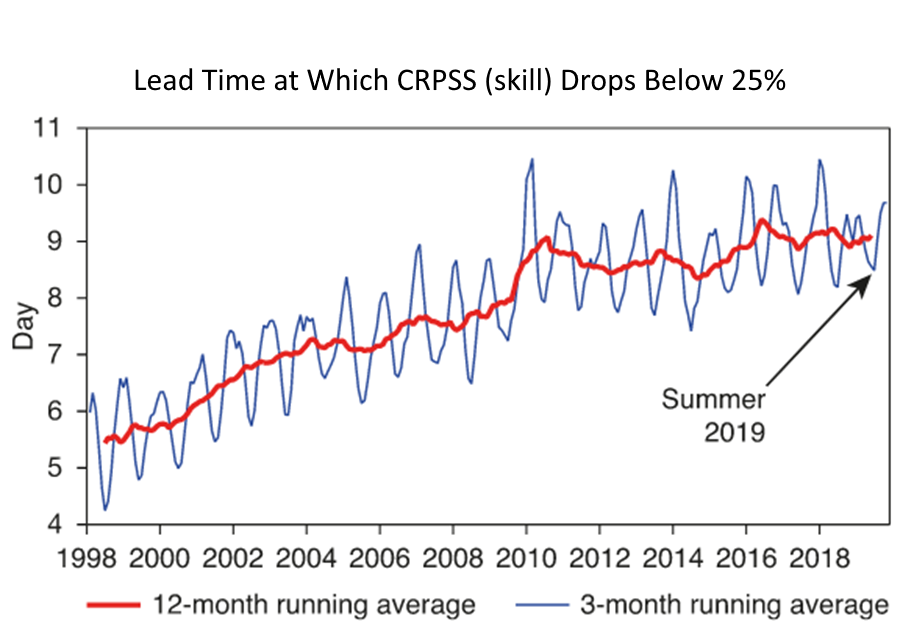
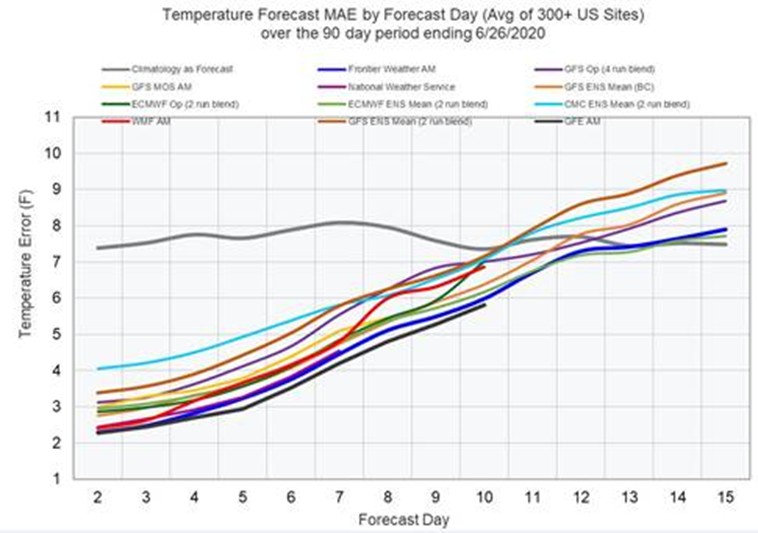

The lack of deterministic weather forecast skill improvements over the past decade inspired the late Dr. Fuqing Zhang, a professor of meteorology at Penn State University, to revisit the 2-week forecasting barrier first proposed by Lorenz in the 1960s.
Traditional weather forecasting is based on the principle that the skill of a weather forecast is based on measuring as much information as possible about the current state of the atmosphere from everywhere on the globe including at the surface and at all altitudes. These are known as “initial conditions”. This information is captured by a wide range of weather observing instruments and systems and loaded into a super-computer to “initialize” the model, which then uses numerical computation to solve the equations of motion and energy. The computers roll the equations forward in time to simulate the atmosphere days and weeks into the future. A weather forecast is born!
Deterministic Forecasting Has a Limit
This dynamical modelling method has proven to be a spectacular success in the short to medium range, i.e. from a few days up to 12 or so days into the future. However, Dr Zhang confirmed that the 2-week barrier for deterministic forecasts can never be penetrated, even if all the computing power in the world were applied to create a forecast.
Fortunately, an innovative and exciting new forecasting approach has taken the world by storm in recent years, challenging traditional norms, and transforming the landscape of long-range forecasting.
How can long-range weather predictions be achieved? World Climate Service scientists have been at the forefront of the new science of long-range forecasts and seasonal climate forecasts for more than a decade. Pioneering work by WCS scientists has resulted in the development of innovative products that provide valuable information across a broad range of applications.
Long-Range Forecast: Boundary Condition Dependent
The global atmosphere (and land/sea surfaces) exhibits large scale cycles which change over long time periods of months to years – often referred to as “Boundary Conditions”. By considering the persistence and evolution of these large-scale boundary conditions (such as the El Niño Southern Oscillation), it has been found that there is useful forecast skill as far as 6-7 months into the future. The long-range forecast skill arises because the forecasts are probabilistic in nature, rather than the specific deterministic forecasts which have no skill 12-14 days into the future.

Whilst dynamical models containing a mathematical representation of the atmosphere also crunch the numbers to produce long-range weather forecasts, the boundary condition signal is much weaker compared to the initial condition signals of the traditional short to medium range weather forecasts. The WCS carefully extracts this signal using dynamical model output from the ECMWF and American CFSv2 models to create a long-range forecast of future weather and climate conditions.
The “boundary conditions” method also lends itself to a forecast method distinctly different than dynamical model forecasts. This type of forecast is called statistical forecasting. Although careful calibration is required, statistical forecasts are relatively easy to produce – no supercomputer or sophisticated dynamical model required! Statistical forecasts use long histories (as much as 100 years) of prior weather and climate conditions to determine what happens on average on a global scale when a cycle (or combination of cycles) of a climate index is in a particular phase.
Despite their simplicity, statistical forecasts of parameters such as temperature and precipitation are often found to be just as successful as those produced by dynamical modelling. They can be a valuable source of independent information for a long range forecast, especially when used in combination with dynamical modelling.
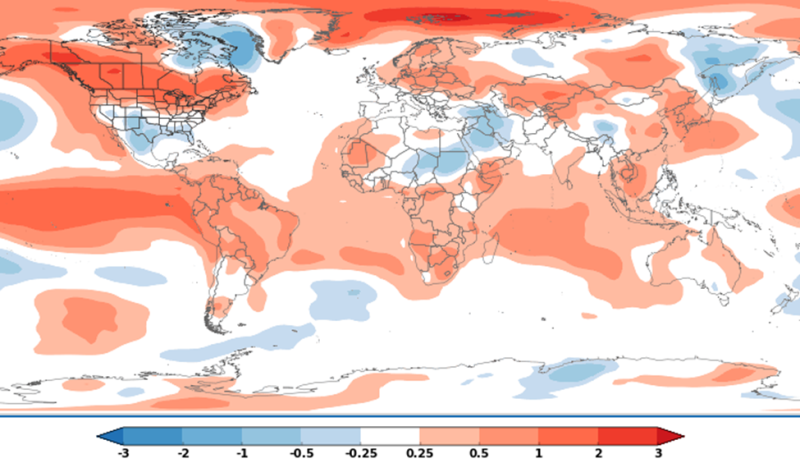
Long-range weather forecasting is different to “traditional” short to medium range weather forecasting in several important ways.
Long-Range Forecasting Time Scales
Long-range forecasts are generally split into two periods:
- sub-seasonal (sometimes referred to as the “extended” range) covers 2 to 6 weeks into the future. The smallest denomination of the forecast is usually one week, and consecutive weeks can be combined. The WCS offers a comprehensive set of sub-seasonal tools and forecast products.
- seasonal covers the period 1 to 9 months ahead. The smallest denomination of this forecast is usually one month, and the forecasts are often presented in 3-month blocks (or seasons). The WCS releases high-quality seasonal outlooks (3-month blocks) each month for temperature and precipitation for North America, Europe and East Asia.
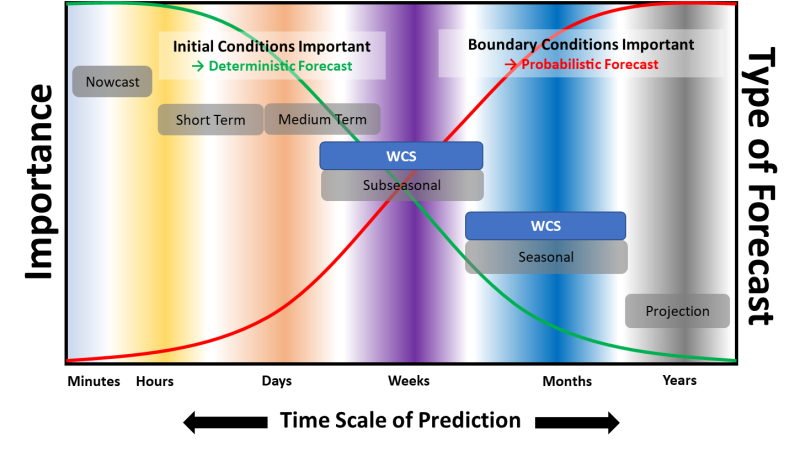
Long-Range Forecast: Type of output
Long-range weather forecasts and seasonal outlooks do not attempt to give us the detail we are used to in traditional weather forecasts (deterministic forecasts), as the daily variation of weather, such as temperature and precipitation, by both location and time, cannot be resolved. What can be detected is the probability of certain anomalies over longer time periods and wider areas. Thus, long-range weather forecasts are probabilistic rather than deterministic. Consequently, WCS seasonal outlooks are issued with a confidence level. When statistical factors align, the forecast is more confident, and confident forecasts of specific outcomes are more likely to verify correctly.
Use of output from long-range forecasts
Traditional deterministic weather forecasts are user-friendly; they tell us the exact temperature and precipitation at an exact time and place. The output of a long-range weather forecast is not quite so obvious. Long-range forecasts tell us the likelihood of a range of outcomes occurring over a fixed time period for a given region.
The seasonal outlook is often presented in terms of 3 terciles of a probability distribution: below normal, near normal, and above normal. On average each category has a 33% chance of happening in any given week/month/season. As the forecast is framed in terms of the probability of outcomes, the user does need some understanding of risk associated with each outcome. The user also needs to understand how they will act to mitigate that risk.
For example, a seasonal outlook for Germany may be showing a 66% chance of above normal temperature and precipitation in June/July/August with moderate confidence. This is very significant as it is double the normal (i.e. 33%) probability of the above normal category. An energy company may be able to act on this information to gain a commercial advantage in the event of increased heat and rains. Of course, there remains a 34% risk that temperature and precipitation turn out to be near normal or below normal, but that may be a risk worth taking.
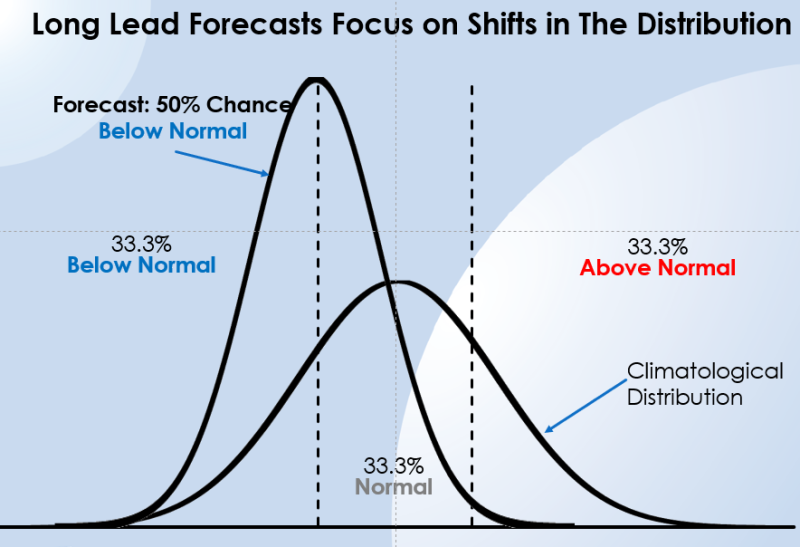
Long-Range Forecast: Types of application
Clearly, long-range forecasts and seasonal outlooks will not appeal to the masses in the same way that traditional short to medium-range weather forecasts do. Long-range forecasts generally appeal to businesses that have financial exposure to weather conditions such as temperature and precipitation and the financial wherewithal to manage the risk. These players will typically already manage a sophisticated operation, and so will easily be able to understand and deploy probabilistic forecasts to manage risk or create opportunities. As the use of the long-range forecast becomes more entrenched in corporations, businesses that are not using seasonal outlooks will find themselves at a commercial disadvantage.
Real-world Long Range Forecast Success: The World Climate Service
Traditional weather forecasting has been around for more than half a century and is improving slowly towards a known limit of predictability as computing power increases. The long-range forecast, including subseasonal and seasonal climate forecasts, on the other hand, is the new kid on the forecasting block. The WCS has been at the forefront of the rapid progress seen over the last 20 years; having started from a modest skill base in temperature and precipitation prediction, we now see significant, tangible, and actionable skill in a range of weather parameters. For example, check out our performance in the Forecast Rodeo.
Request a trial of the World Climate Service today.